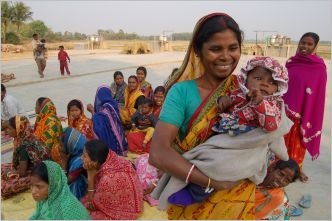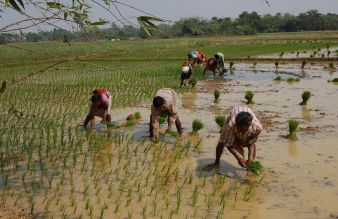Burdman (West Bengal): For 42-year-old Poornima Khan and women of her age in Bhagawatipur village of Burdman district in West Bengal, last two years have been much better.
"Our income saw a little improvement," Poornima says. "Three years ago, we were housewives. Today, two-three hours of work brings home some money."

![]() Members of women Self Help Group at a paddy processing centre. Pic: Shankar.
Members of women Self Help Group at a paddy processing centre. Pic: Shankar.
The ten-member self-help-group, of which Poornima is a member, is the village's paddy procurement agency. "We buy paddy, process it here and sell it to the rice mills, it fetches better price," she says. "May be we can own a rice mill one day."
Mistake not, Poornima's dreams are not without any grounding. Within a couple of years, she may in fact be a member of rice-mill management board.
"That's our ultimate aim, and we are on the course," says Uday Sarkar, President of Burdman Zilla Parishad. "We'd like the SHGs to go beyond procurement and processing of paddy and start a rice mill of their own to earn maximum benefit."
With 72 per cent of the cultivable land in the hands of small and sub-marginal farmers, pressure on agriculture is immense. With man-days in farm sector falling and incomes dwindling, shifting of people to other occupations is inescapable.
"Our effort is that the women's Self-Help-Groups (SHGs) should take over the task of processing, so that the money does not move out of the rural economy and that's where the government intervention is so crucial," Sarkar says. "Every year," he estimates, "farmers have to sell 25 per cent of their paddy yields owing to distress. They lose roughly Rs 20 crore on that account. We needed to stop it."
The state government on its part lent Rs.10 crore to the SHGs upfront to buy paddy and curb distress sales by the farmers to rice mills.
The locals built what is called in local parlance as chautals', meaning a concrete paddy processing unit, with a small office for the SHG.
Rs.20 crore which would have otherwise moved out of the rural economy, has been kept within, and this has helped nearly 3000 members, all landless, of the groups to generate some degree of income, according to Zilla Parishad (Burdman) and agriculture department estimates. "If the government keeps supporting us, we will develop our group and incomes further," says Bandana Roy, a SHG member. "There is scope for diversification."
While Maharashtra Government withdrew its intervention in procurement by abolishing the monopoly cotton procurement scheme two years ago, right when the farmers are going through the worst-ever agrarian crisis of modern times, the West Bengal government has mopped up its resources for the same. And one has to see it to believe the remarkable difference in rural economy, notwithstanding the criticism from proponents of neo-liberalism of that model as bad economics.
Sudden withdrawal of the government intervention in procurement left farmers in a lurch in Vidarbha and Marathwada, and allowed private buyers to establish their monopoly in short span. In West Bengal exactly opposite is happening.

![]() A rice field in Burdman. Pic: Shankar.
A rice field in Burdman. Pic: Shankar.
Model experiments in districts like Burdman, 120 km away from Kolkata, are heading for success. In two years time, as the government pumps in money, the SHGs may actually run rice mills and not just procure and process the paddy.
"It would achieve two important objectives," holds Sarkar, an unassuming ZP President. "One, it would improve the income levels and check distress sales and two, it would shift the surplus agricultural population to agro-industries."
Bengal's major challenge in the years to come is to shift the surplus agricultural population to off-agriculture activities, while keeping the links in tact. While the CPM government is facing stiff resistance to its industrialization policies not only from the opposition but also from within its own Left-constituent forces, there is no escape from little industrialization. And looking at its huge agriculture base, agro-processing and agro-industries is another way to generate employment and stay in the fast changing economic conditions scripted by the Central policies.
"The human development report 2005 actually shows that the non-farm activity in West Bengal has gone up," claims the Industries Minister, Nirupam Sen.
"Challenges before the government with regard to agriculture are huge." On the one hand is the fast fragmenting land holding (nearly 80% of the 135 lakh acres of the farm land in West Bengal is shared by small and marginal farmers with holding of less than one acre); on the other hand is the onslaught of policies on agriculture.
"We've to see how do we assure connectivity and generate a market place for those who would shift from farms. At the same time, we've to raise the income of rural households, and our efforts are to strengthen the Self Help Groups through credible micro-finance and easy market links to their products," Sen explains.
True, Bengal has its share of poverty and crisis, particularly in its four western districts. The difference is in the way that government is reacting to the problems.
In a progressive state like Maharashtra, farmers are committing suicide every day; in West Bengal, largely portrayed by neo-liberals as one of the backward and hungry states of the country, even the sub-marginal farmer of less than one bigha landholding (one bigha = one third of an acre) is slowly taking over the processing of paddy, with a strong intervention of the communist-regime. What is more, it's far from hungry. Farmers are poor, but not as acutely indebted.
The Bengal model shows us that the State intervention does make a difference. As Dr M S Swaminathan, the father of green revolution once remarked: "Nowhere in the world can farmers survive without the State's support."
When every single state of India, including Narendra Modi's Gujarat, is ailing from growing inequalities between urban and rural communities, the farmers are taking the stick the hardest way. With the Centre is set to give up its responsibility over the eleventh plan period, states are left to cope with the daunting task of saving their peasantry. Different states are reacting differently towards farm sector, even as the Centre-scripted policy shifts affect all of them bitterly. By most signs, the ongoing crisis is only likely to deepen, and distress levels in rural parts could soar.
"We succeeded in coming out of the clutches of moneylenders because here the primary agriculture cooperative societies (PACS) are very strong; they get solid support from the West Bengal government," explains Sarkar. In Maharashtra, particularly Vidarbha, moneylenders are a grim reality; over 50 per cent farmers who are still out of the institutional credit network borrow from private sources.
The PACS in West Bengal have a capital of Rs.7,500 crore, which is lent to farmers twice a year in Kharif and Rabi seasons. Even the share-croppers and landless labourers can become members of PACS by paying a nominal Re 1 fee. What's more, the landless could also get loan from the societies in emergency.
Unlike Maharashtra, the credit recovery rate in West Bengal is a solid 98 per cent. "That is because our interest rates are only four to seven per cent," says Sarkar. And every farmer-member realizes the importance of repaying the credit on time, to be able to borrow money from the same society for the next crop.
Contrarily, in Vidarbha, PACS are defunct or bankrupt, because their members are in doldrums. And it's here that the real difference lies.

